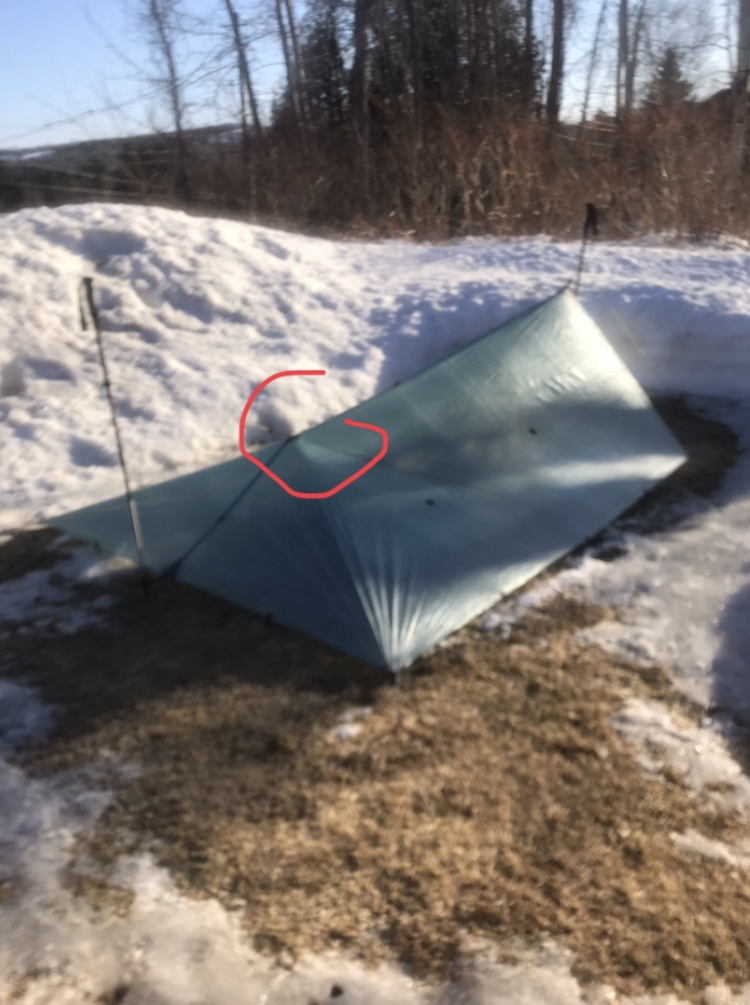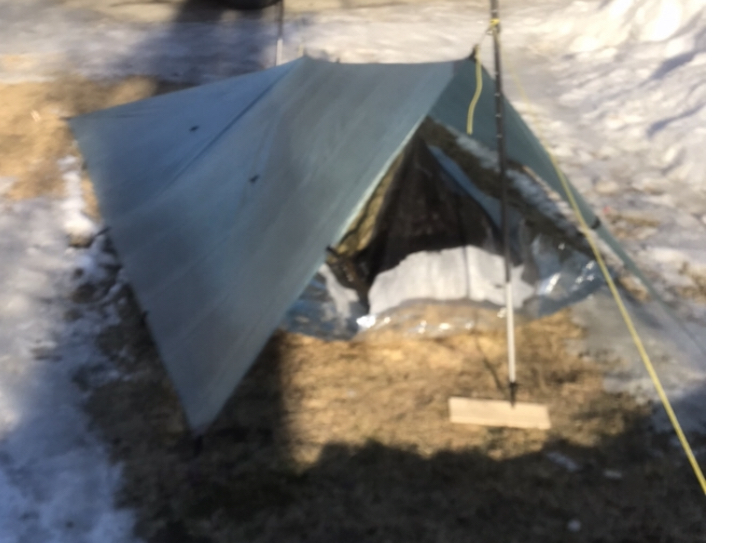Topic
Are You 6’1”? Is a 7.5×9.5 tarp a good size?
Forum Posting
A Membership is required to post in the forums. Login or become a member to post in the member forums!
Home › Forums › Gear Forums › Gear (General) › Are You 6’1”? Is a 7.5×9.5 tarp a good size?
- This topic has 4 replies, 3 voices, and was last updated 5 years, 8 months ago by
Anonymous.
-
AuthorPosts
-
May 26, 2019 at 1:13 am #3594652
Hi all,
Just bought my first flat tarp. I was looking for an 8×10 (my friend told me this was my size) but I just got a great deal on a 7.5×9.5 I couldn’t pass up. Anyone my size (6’1 200lbs) have experience with this size? Is it big enough? I want to get into tarping, mainly the 1/2 pyramid and A frame. Thx
Cal
May 26, 2019 at 2:54 am #3594665Anonymous
InactiveNot your size, but just want to note that .5′ difference each dimension isn’t really much of a difference all in all–certainly not a make or break it type difference. Are you planning on using any kind of bivy? A simple bivy is one of the easiest things to make btw. If you don’t have a sewing machine and don’t want to/can’t invest in one, Walmart often has a cheap polypropylene fabric (unfortunately non woven, would be better if woven) that is reasonably durable and reasonably lightweight, and to which you can either hot glue together or tape with Tyvek tape together (and turn it inside out after so the tape isn’t showing).
The PP fabric is permanent DWR, quite breathable, and the material is less thermally conductive than most others, which can help cut down condensation forming some on one’s quilt/bag. It’s not even close to be water proof, but it is in between slightly to moderately water resistant and that’s all a bivy really needs. You would still need some waterproof material underneath you if going that route.
Best of luck
May 26, 2019 at 11:39 am #3594697
 Hey Cal- I’m 6’2” that should be plenty spacious under there for you. I used to have an 8×10 and switched recently to a cat cut 7.5×9.5. I’ve slept a few times in the rain under it and there was probably 12-18” of dry ground at my head and feet area. The size is plenty big for gear as well. If your looking for good alternate pitches I found “storm mode” to be the best at shedding wind and keeping precipitation from blowing into the shelter. Also i fit into the shape, whereas the half pyramid shape was a little cramped for me and this was with an 8×10. Pics are of storm mode. Basically storm mode is A-frame but with the windward side pegged tight to the ground, 3 sides end up close to the ground and one side A-frame. I added a simple guy tie out point about 30” up the ridge to elevate the foot area by tying it off to my other hiking pole and pegging. Now if on the Aframe end you peg not the corners but the first tie outs, you can kind of make a door of sorts by bringing the corners to meet in the middle under the ridge. This usually isn’t necessary except in the worst weather but it also gives privacy if you’re in a campsite… it’s called the Tetra WedgeMay 26, 2019 at 11:59 am #3594699
Hey Cal- I’m 6’2” that should be plenty spacious under there for you. I used to have an 8×10 and switched recently to a cat cut 7.5×9.5. I’ve slept a few times in the rain under it and there was probably 12-18” of dry ground at my head and feet area. The size is plenty big for gear as well. If your looking for good alternate pitches I found “storm mode” to be the best at shedding wind and keeping precipitation from blowing into the shelter. Also i fit into the shape, whereas the half pyramid shape was a little cramped for me and this was with an 8×10. Pics are of storm mode. Basically storm mode is A-frame but with the windward side pegged tight to the ground, 3 sides end up close to the ground and one side A-frame. I added a simple guy tie out point about 30” up the ridge to elevate the foot area by tying it off to my other hiking pole and pegging. Now if on the Aframe end you peg not the corners but the first tie outs, you can kind of make a door of sorts by bringing the corners to meet in the middle under the ridge. This usually isn’t necessary except in the worst weather but it also gives privacy if you’re in a campsite… it’s called the Tetra WedgeMay 26, 2019 at 11:59 am #3594699@Justin: Thanks. Im planning on a bivvy. Great thought about the Walmart PP material. I’ll check it out. I’ve got some spare Tyvek too I could probably use as well. Right now I’m looking to tarp in the winter and shoulder seasons when snow is more of an issue, then go with my netted tent during bug season. My quilt has a dwr finish that I’m hoping would handle any spindrift, or is it still better to have the bivvy for moisture?
@Dave: Thx for the tip. I’ll check out the wedge. The tarp I’ve got is DCF as well. Where did you get your tieout? Does MLD, HMG, Zpacks still sell stickons? Was checking Zpacks the other day and couldn’t find them. My Tarp is MLD. I haven’t gotten it yet but it’s supposed to have 26 tieouts. ThxMay 26, 2019 at 2:48 pm #3594720Anonymous
InactiveHi Cal, I”ve used a Tyvek bivy before, and don’t particularly recommend it, especially not for winter use; warm temp use is ok. Specifically I used “kite” 1443R Tyvek.
In some ways, Tyvek and polypropylene are opposites. Tyvek is unusually thermally conductive and polypropylene is unusually non thermally conductive. Tyvek will tend to have condensation form in between the top of the quilt and below the inner tyvek. Polypropylene will tend to help drive it up to the top of the bivy.
Also, the PP fabric is definitely far more breathable, which is important especially for winter use. The small pores of the Tyvek could potentially ice up some, especially since the material is so thermally conductive, cutting down breathability.
The PP fabric is definitely a bit heavier, but that also makes it more stout. If you can sew or find someone who can, I might use some silnylon with some silicone V’s painted on for the bottom.
-
AuthorPosts
- You must be logged in to reply to this topic.
Forum Posting
A Membership is required to post in the forums. Login or become a member to post in the member forums!
HAPPENING RIGHT NOW (February 11-21, 2025) - Shop Hyperlite Mountain Gear's Biggest Sale of the Year:
Our Community Posts are Moderated
Backpacking Light community posts are moderated and here to foster helpful and positive discussions about lightweight backpacking. Please be mindful of our values and boundaries and review our Community Guidelines prior to posting.
Get the Newsletter
Gear Research & Discovery Tools
- Browse our curated Gear Shop
- See the latest Gear Deals and Sales
- Our Recommendations
- Search for Gear on Sale with the Gear Finder
- Used Gear Swap
- Member Gear Reviews and BPL Gear Review Articles
- Browse by Gear Type or Brand.


 Hey Cal- I’m 6’2” that should be plenty spacious under there for you. I used to have an 8×10 and switched recently to a cat cut 7.5×9.5. I’ve slept a few times in the rain under it and there was probably 12-18” of dry ground at my head and feet area. The size is plenty big for gear as well. If your looking for good alternate pitches I found “storm mode” to be the best at shedding wind and keeping precipitation from blowing into the shelter. Also i fit into the shape, whereas the half pyramid shape was a little cramped for me and this was with an 8×10. Pics are of storm mode. Basically storm mode is A-frame but with the windward side pegged tight to the ground, 3 sides end up close to the ground and one side A-frame. I added a simple guy tie out point about 30” up the ridge to elevate the foot area by tying it off to my other hiking pole and pegging. Now if on the Aframe end you peg not the corners but the first tie outs, you can kind of make a door of sorts by bringing the corners to meet in the middle under the ridge. This usually isn’t necessary except in the worst weather but it also gives privacy if you’re in a campsite… it’s called the Tetra Wedge
Hey Cal- I’m 6’2” that should be plenty spacious under there for you. I used to have an 8×10 and switched recently to a cat cut 7.5×9.5. I’ve slept a few times in the rain under it and there was probably 12-18” of dry ground at my head and feet area. The size is plenty big for gear as well. If your looking for good alternate pitches I found “storm mode” to be the best at shedding wind and keeping precipitation from blowing into the shelter. Also i fit into the shape, whereas the half pyramid shape was a little cramped for me and this was with an 8×10. Pics are of storm mode. Basically storm mode is A-frame but with the windward side pegged tight to the ground, 3 sides end up close to the ground and one side A-frame. I added a simple guy tie out point about 30” up the ridge to elevate the foot area by tying it off to my other hiking pole and pegging. Now if on the Aframe end you peg not the corners but the first tie outs, you can kind of make a door of sorts by bringing the corners to meet in the middle under the ridge. This usually isn’t necessary except in the worst weather but it also gives privacy if you’re in a campsite… it’s called the Tetra Wedge

